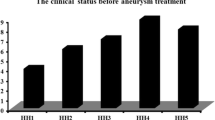Summary
The clinical effect of combination therapy with high doses of intravenous nicardipine and intra-arterial infusion of papaverine on symptomatic vasospasm after subarachnoid haemorrhage (SAH) was analysed retrospectively. In 66 of 122 patients who underwent early aneurysm surgery between 1990 and 1993, the intracranial haemodynamics were documented by transcranial Doppler (TCD) ultrasonography. 33 of these 66 patients received high dose nicar-dipine intravenously (Group I); the other 33 patients were not treated with calcium antagonists (Group II). Symptomatic vasospasm occurred in 6 Group I patients (18%) and in 13 (39%) in Group II patients. All 19 symptomatic patients received an intra-arterial infusion of papaverine; 15 patients (79%) responded well to this therapy and the symptoms were reversed quickly. Although the mean flow velocity (MFV) was not different between the two groups, it was reduced significantly after papverine infusion.
Our retrospective analysis suggests that symptomatic vasospasm can be treated effectively with the combination of intravenous high dose nicardipine and intra-arterial infusion of papaverine, and that the correct timing of the infusions is crucial.
Similar content being viewed by others
References
Alasdair JG, Bevan JA (1993) Flow-induced relaxation of the rabbit middle cerebral artery is composed of both endothelium-dependent and -independent components. Stroke 24: 105–110
Bevan JA, Joyce EH (1990) Flow-induced resistance artery tone: balance between constrictor and dilator mechanisms. Am J Physiol (Heart Circ Physiol 27) 258: 663–668
Fisher CM, Kistler JP, Davis JM (1980) Relation of cerebral vasospasm to subarachnoid hemorrhage visualized by computerized tomographic scanning. Neurosurgery 6: 1–9
Flamm ES, Adams HP, Beck DW (1988) Dose-escalation study of intravenous nicardipine in patients with aneurysmal subarachnoid hemorrhage. J Neurosurg 68: 393–400
Frazee JG, Bevan JA, Bevan RD (1985) Effect of diltiazem on experimental chronic vasospasm in the monkey. J Neurosurg 62: 912–917
Grosset DG, Straiten J, McDonald I (1993) Use of transcranial Doppler sonography to predict development of a delayed ischemic neurological deficit after subarachnoid hemorrhage. J Neurosurg 78: 183–187
Haley EC Jr, Kassell NF, Torner JC (1993) A randomized controlled trial of high-dose intravenous nicardipine in aneurysmal subarachnoid hemorrhage. J Neurosurg 78: 537–547
Haley EC Jr, Kassell NF, Torner JC (1993) A randomized trial of nicardipine in subarachnoid hemorrhage; angiographic and transcranial Doppler ultrasound results. J Neurosurg 78: 548–553
Harders AG, Gilsbach JM (1987) Time course of blood velocured by transcranial Doppler ultrasound. J Neurosurg 66: 718–728
Higashida RT, Halbach VV, Leslie D (1989) Transluminal angioplasty for treatment of intracranial arterial vasospasm. J Neurosurg 71: 648–653
Kaku Y, Yonekawa Y, Tsukahara T (1992) Superselective intra-arterial infusion of papaverine for the treatment of cerebral vasospasm after subarachnoid hemorrhage. J Neurosurg 77: 842–847
Kassell NF, Sasaki T, Colohan ART (1985) Cerebral vasospasm following aneurysmal subarachnoid hemorrhage. Stroke 14: 562–572
Krueger C, Wier B, Nosko M (1985) Nimodipine and chronic vasospasm in monkeys: part 2. Pharmacological studies of vessels in spasm. Neurosurgery 16: 137–140
Kuwayama A, Zervas NT, Shintani A (1972) Papaverine hydrochloride and experimental hemorrhagic cerebral arterial spasm. Stroke 3: 27–33
Masahiro O, Marshall BM, Lougheed WM (1973) Observations on the effects of intrathecal papaverine in experimental vasospasm. J Neurosurg 38: 20–25
Miyamoto M, Takayanagi I, Ohkuba H (1976) Actions of papaverine on intestinal smooth muscle and ints inhibition of cyclic AMP and cyclic GMP phosphodiesterases. Jpn J Pharmacol 26: 114–117
Newell DW, Eskridge JM, Mayberg MR (1989) Angioplasty for the treatment of symptomatic vasospasm following subarachnoid haemorrhage. J Neurosurg 71: 654–660
Pasqualin A, Tsukahara T, Kassell NF (1992) Effect of nicardipine on basilar artery vasoactive responses after subarachnoid hemorrhage. Neurosurgery 31: 697–704
Tsukahara T, Arista A, Kassell NF (1989) The distribution of intravenous nicardipine in rat brain after subarachnoid hemorrhage. Surg Neurol 32: 188–194
Zubkov YN, Nikiforov BM, Shustin VA (1984) Balloon catheter technique for dilatation of constricted cerebral arteries after aneurysmal SAH. Acta Neurochir (Wien) 70: 65–79
Author information
Authors and Affiliations
Rights and permissions
About this article
Cite this article
Yoshimura, S., Tsukahara, T., Hashimoto, N. et al. Intra-arterial infusion of papaverine combined with intravenous administration of high-dose nicardipine for cerebral vasospasm. Acta neurochir 135, 186–190 (1995). https://doi.org/10.1007/BF02187766
Issue Date:
DOI: https://doi.org/10.1007/BF02187766




